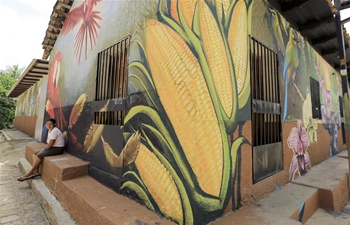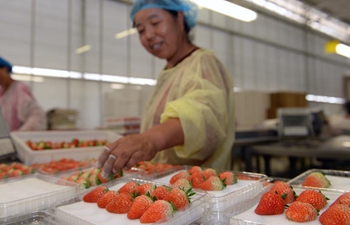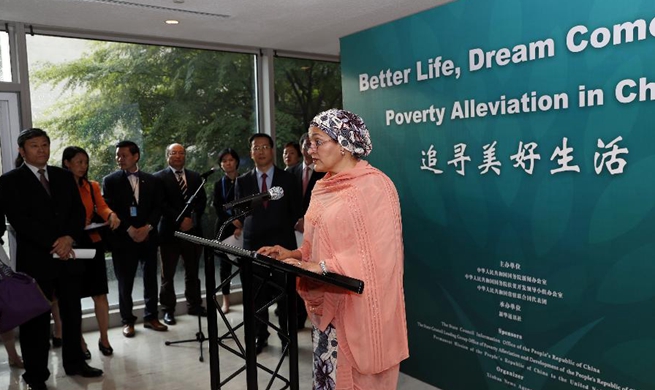MEXICO CITY, June 30 (Xinhua) -- Whenever Guillermo Danino traveled abroad, he would go to bookstores. And whenever he visited a bookstore, he would seek out the Chinese section for books on Chinese culture.
The Peruvian sinologist has a library of books on China in five languages -- Spanish, Italian, English, French and Chinese. His knowledge of the Chinese language and culture grew when he went to Nanjing City in eastern China in 1979 to teach Spanish.
Today, he is the author of over two dozen books on China, including an impressive Encyclopedia of Chinese culture.
The octogenarian has seen China's transformation firsthand.
"I have witnessed what it's like when a country booms, how it emerges from misery, hunger and lack of employment ... how it really becomes a power," he said.
"They say that never before in the history of the world has a country grown and developed so much in such a short time... (It has been possible) because everyone works, everyone makes the biggest effort they can to develop their environs, their home, their community."
Danino, who has also acted in Chinese films, called the Chinese hard workers as well as voracious learners. "They are eager to learn, collaborate and communicate," he said. "I think one of the reasons behind the progress is their capacity for work. Apart from using their intelligence, they work hard."
EDUCATION FOR TRANSFORMATION
As Carlos Rojas Magnon, head of the Bilateral Mexico-China Business Owners Committee, sees it, investment in education has been a key factor in China's transformation from a mass producer of basic items to a leader in technological innovations.
"We can learn a lot (from China), such as dedication, work ethics, sense of duty, and the great importance that China and the Chinese place on education," Magnon, who is also the China expert at the Mexican Business Council for Foreign Trade, Investment and Technology, said. "What is surprising is the incredible speed with which (China's transformation) took place ... and I think it all began with the tremendous value placed on education."
Today Latin America is struggling with many of the development problems that China once faced, said Mario Cimoli, deputy executive secretary of the United Nations Economic Commission for Latin America and the Caribbean.
"I think China is showing Latin America how to be a market economy while having the state orient and transform the productive structure and make it competitive," Cimoli, who has authored a book, "Innovation and Economic Development", said.
The economic reform China launched in 1978 called for a greater free market, greater access to international trade, greater access to exports and imports, and greater access to outside technologies, he said.
The resultant evolution in China has a positive impact on its ties with Latin America, he said, "leading to changes in Latin America's productive structure through trade, investment, and scientific and technological cooperation."
In 2017, trade between China and Latin America rose 18.8 percent to nearly 260 billion U.S. dollars, making China the region's second biggest trade partner. China's exports to the region amounted to 130.8 billion dollars while its imports from the region reached 127 billion dollars.
For Latin America, the best way forward is to expand cooperation and partnerships with China in a variety of fields, including science and technology, financing and investment, Cimoli added.
COOPERATION OPPORTUNITIES
The Belt and Road Initiative provides a wide range of opportunities for cooperation. Panama and China, for instance, signed a memorandum of understanding to promote the initiative, making Panama the first Latin American country to do so.
As home to the strategic Panama Canal that provides a shipping shortcut between the Pacific and Atlantic oceans, the Central American country is ideally situated to help expand trade with the rest of the region.
The two countries are now studying the feasibility of building a rail line connecting Panama City with the western coast province of Chiriqui to facilitate cargo shipments.
In South America, Argentina has been undertaking large-scale cooperation projects with China for years, and more are planned for the future, Argentine economist Maria Cecilia Peralta said in an earlier interview.
"The majority of these are infrastructure projects, like the construction of dams in the south of the country, and the Aguas Negras tunnel that links Argentina to Chile, an initiative that is very beneficial for regional trade," Peralta said.
Mexican trade expert Magnon is also advocating that China and Latin America learn more about each other. According to him, China should expand the network of its Confucius Institutes to increase academic and cultural exchanges.
In recent years, people in Latin America have developed a greater understanding of China via cultural and people-to-people exchanges through education, sports and tourism.

















